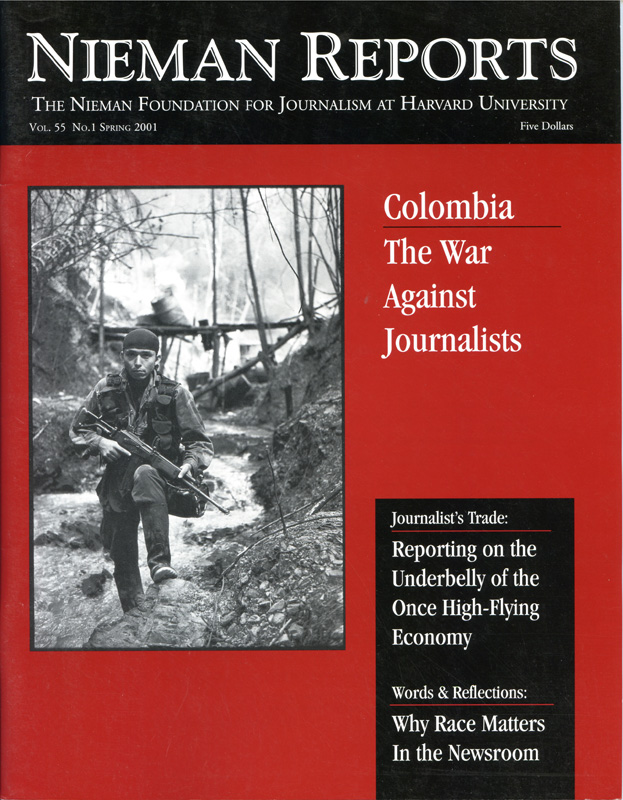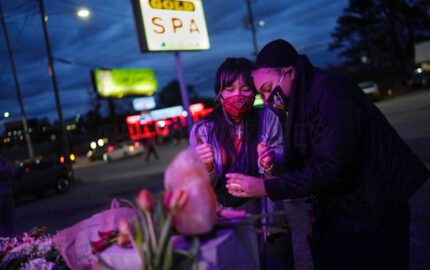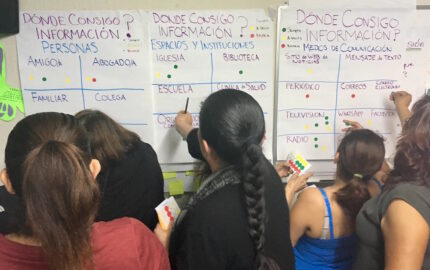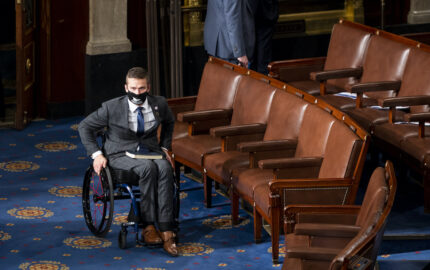
Colombia: The War Against Journalists
Reporting on Colombia’s war is extremely dangerous for journalists. For what they publish and broadcast, reporters are threatened and harassed, kidnapped and beaten, driven into exile and murdered. Only in Algeria have more journalists been murdered during recent years in retaliation for the work they do.
Some San Antonio Express-News staffers approached their paper’s newsroom diversity training last year with “great dread.” They complained of being “volunteered” to go because response to invitations was poor. Phrases like “a lot of PC crap” and “a bunch of eggheads” showed just how low their expectations were of the Maynard Institute for Journalism Education’s workshop.
But sometime during the second day, the tide began to turn. “As we got into day two I really started to see the value in [the training],” one skeptic told a Ford Foundation consultant one month later. “And the value in it, from one simple standpoint, was for me when you are incorporating diversity in your newspaper, you are dealing in the realm of accuracy. Accuracy in representing your community. And accuracy in newspapers is credibility and everything else. And that really was the turning point.”
After 11 years of research and work with journalists on strategies to make news coverage more inclusive, I’m accustomed to newsroom skeptics. The knee-jerk reaction to any attempt to address bias in news coverage is to dismiss it as “PC crap,” like the Express-News staffer did. Such attitudes blind journalists to the impact of news coverage on credibility and the relationship between credibility and the bottom line, especially among people of color, who comprise the plurality or majority of populations in most major U.S. media markets. That said, some editors and publishers do “get it,” including the top management at the Express-News.
The workshop the Maynard Institute led in San Antonio last March is called “Reality Checks.” It is part of the Institute’s Total Community Coverage (TCC) program. Based on the Fault Lines framework created by the late Robert C. Maynard and developed by his daughter, Dori, Reality Checks weds readership and community demographics with content analysis to empower journalists to audit their coverage and to develop strategies to make it more inclusive. Led by current and former journalists, Reality Checks workshops have been conducted at three newspapers over the past 18 months, including the Express-News. The Institute also analyzed coverage in a fourth newspaper using the Reality Checks model.
Robert C. Maynard, former Oakland Tribune publisher, identified five enduring Fault Lines of race, class, gender, generation and geography as the prisms through which many of us see the world. He wrote: “The society is split along five faults, and we try in vain to paper them over, fill them in or pretend they aren’t there. These underlying forces, like those in the center of the earth, will thwart us until we come to see our differences as deep but completely natural things, as natural as geologic fault lines.”
Fault Lines are not only social but personal. Maynard Institute President Dori Maynard believes Fault Lines not only make us who we are but create “blind spots” that render us unable to “see or make sense of some of the complexities in our communities and/or in others, including our newsroom colleagues.”
The three-day Reality Checks workshop opens with a Fault Lines orientation. In successive sessions, participants use the Fault Lines framework to
They also learn about the impact of their Fault Lines on the subconscious practice of news framing. News frames refer to the main theme—some call it the “master narrative”—conveyed by a story. It is the central idea around which facts are organized.
The third day largely focuses on training and preparing participants to collect and enter data for a content audit of their newspaper using coding sheets and software that Maynard provides. Afterward, participants spend a fourth day auditing local news coverage on their own. Maynard analyzes the data and writes a report for presentation to participants and whomever else the paper wants to invite. San Antonio, a Maynard TCC partner since 1995, sponsored five sessions last July, including three for newsroom employees, one for its community advisory board, and one for its operations committee. So far most Reality Checks workshops have focused on the news side, but one workshop also included business side staff.
It’s too soon to evaluate the impact of Reality Checks, but from the content audits similarities emerge in coverage patterns and in the relationship between the findings and the quality of reporting and decision-making. Not surprisingly, the most frequent source of news is an upper-middle-class, white, male Baby Boomer who lives on the affluent side of town. The diversity of voices increases in proportion to sources. The more sources, the less likely they are to be the “usual suspects.” The same is true of enterprise vs. spot news reporting. Coverage depicting people of color tends to be played more on Page One, metro, sports and feature section fronts than on inside pages.
The Fault Line portrait of the “typical” news source and the pattern of placement of stories depicting people of color reflect multiple factors: social reality, conventional news values and practices, and the Fault Line “blind spots” of the journalists who produced the coverage. Most news emanates from the corridors of power, which once again are filled with upper-middle-class, white, male Baby Boomers. The inroads blacks and, to a lesser extent, Latinos have made in local government could account for the prominent placement of stories depicting people of color. The sports section consistently ranks among the top three areas of news which depict people of color in most newspapers, and the Reality Checks newspapers were no different. The sheer volume coupled with the dominance of black athletes and the fact that sports news quite often spills onto news pages provides another explanation of the placement finding.
There is little surprising in these findings, especially for workshop participants who collect the data. “You know we recognize that the newspaper reflects too much the white male. And even if we don’t want to admit it, there’s not a journalist in the room who doesn’t know that that’s true,” said another Express-News workshop participant. What has been different, in my experience, is the reaction of others in the newsroom who did not attend the workshop. It’s harder to dismiss the work of colleagues than of an outside consultant, especially if backed by management commitment and resolve to instill a sense of diversity as an integral part of accuracy and credibility in journalism.
“I don’t see TCC as more black or brown faces,” said Carolina Garcia, Express-News managing editor. “This is about journalism and raising the bar on reporting and being out in the community.”
Erna Smith is interim programs director for the Maynard Institute for Journalism Education. A former newspaper reporter and editor, she is a professor and former chair of the San Francisco State University journalism department and a 1992 fellow at the Shorenstein Center on Press, Politics and Public Policy in Harvard University’s John F. Kennedy School of Government.
But sometime during the second day, the tide began to turn. “As we got into day two I really started to see the value in [the training],” one skeptic told a Ford Foundation consultant one month later. “And the value in it, from one simple standpoint, was for me when you are incorporating diversity in your newspaper, you are dealing in the realm of accuracy. Accuracy in representing your community. And accuracy in newspapers is credibility and everything else. And that really was the turning point.”
After 11 years of research and work with journalists on strategies to make news coverage more inclusive, I’m accustomed to newsroom skeptics. The knee-jerk reaction to any attempt to address bias in news coverage is to dismiss it as “PC crap,” like the Express-News staffer did. Such attitudes blind journalists to the impact of news coverage on credibility and the relationship between credibility and the bottom line, especially among people of color, who comprise the plurality or majority of populations in most major U.S. media markets. That said, some editors and publishers do “get it,” including the top management at the Express-News.
The workshop the Maynard Institute led in San Antonio last March is called “Reality Checks.” It is part of the Institute’s Total Community Coverage (TCC) program. Based on the Fault Lines framework created by the late Robert C. Maynard and developed by his daughter, Dori, Reality Checks weds readership and community demographics with content analysis to empower journalists to audit their coverage and to develop strategies to make it more inclusive. Led by current and former journalists, Reality Checks workshops have been conducted at three newspapers over the past 18 months, including the Express-News. The Institute also analyzed coverage in a fourth newspaper using the Reality Checks model.
Robert C. Maynard, former Oakland Tribune publisher, identified five enduring Fault Lines of race, class, gender, generation and geography as the prisms through which many of us see the world. He wrote: “The society is split along five faults, and we try in vain to paper them over, fill them in or pretend they aren’t there. These underlying forces, like those in the center of the earth, will thwart us until we come to see our differences as deep but completely natural things, as natural as geologic fault lines.”
Fault Lines are not only social but personal. Maynard Institute President Dori Maynard believes Fault Lines not only make us who we are but create “blind spots” that render us unable to “see or make sense of some of the complexities in our communities and/or in others, including our newsroom colleagues.”
The three-day Reality Checks workshop opens with a Fault Lines orientation. In successive sessions, participants use the Fault Lines framework to
- compare and contrast readership demographics with the general population demographics of their circulation area,
- analyze news story sources and photo subjects,
- brainstorm story ideas, and
- analyze news coverage over time.
They also learn about the impact of their Fault Lines on the subconscious practice of news framing. News frames refer to the main theme—some call it the “master narrative”—conveyed by a story. It is the central idea around which facts are organized.
The third day largely focuses on training and preparing participants to collect and enter data for a content audit of their newspaper using coding sheets and software that Maynard provides. Afterward, participants spend a fourth day auditing local news coverage on their own. Maynard analyzes the data and writes a report for presentation to participants and whomever else the paper wants to invite. San Antonio, a Maynard TCC partner since 1995, sponsored five sessions last July, including three for newsroom employees, one for its community advisory board, and one for its operations committee. So far most Reality Checks workshops have focused on the news side, but one workshop also included business side staff.
It’s too soon to evaluate the impact of Reality Checks, but from the content audits similarities emerge in coverage patterns and in the relationship between the findings and the quality of reporting and decision-making. Not surprisingly, the most frequent source of news is an upper-middle-class, white, male Baby Boomer who lives on the affluent side of town. The diversity of voices increases in proportion to sources. The more sources, the less likely they are to be the “usual suspects.” The same is true of enterprise vs. spot news reporting. Coverage depicting people of color tends to be played more on Page One, metro, sports and feature section fronts than on inside pages.
The Fault Line portrait of the “typical” news source and the pattern of placement of stories depicting people of color reflect multiple factors: social reality, conventional news values and practices, and the Fault Line “blind spots” of the journalists who produced the coverage. Most news emanates from the corridors of power, which once again are filled with upper-middle-class, white, male Baby Boomers. The inroads blacks and, to a lesser extent, Latinos have made in local government could account for the prominent placement of stories depicting people of color. The sports section consistently ranks among the top three areas of news which depict people of color in most newspapers, and the Reality Checks newspapers were no different. The sheer volume coupled with the dominance of black athletes and the fact that sports news quite often spills onto news pages provides another explanation of the placement finding.
There is little surprising in these findings, especially for workshop participants who collect the data. “You know we recognize that the newspaper reflects too much the white male. And even if we don’t want to admit it, there’s not a journalist in the room who doesn’t know that that’s true,” said another Express-News workshop participant. What has been different, in my experience, is the reaction of others in the newsroom who did not attend the workshop. It’s harder to dismiss the work of colleagues than of an outside consultant, especially if backed by management commitment and resolve to instill a sense of diversity as an integral part of accuracy and credibility in journalism.
“I don’t see TCC as more black or brown faces,” said Carolina Garcia, Express-News managing editor. “This is about journalism and raising the bar on reporting and being out in the community.”
Erna Smith is interim programs director for the Maynard Institute for Journalism Education. A former newspaper reporter and editor, she is a professor and former chair of the San Francisco State University journalism department and a 1992 fellow at the Shorenstein Center on Press, Politics and Public Policy in Harvard University’s John F. Kennedy School of Government.


